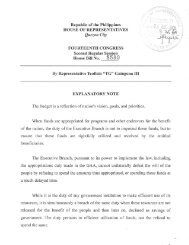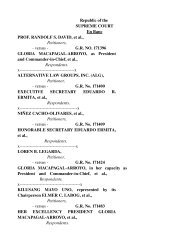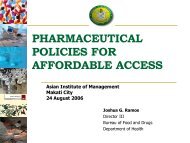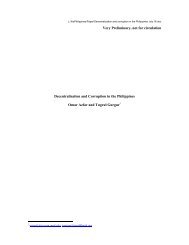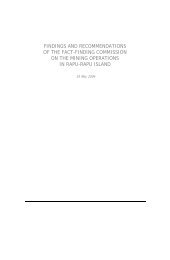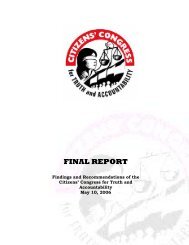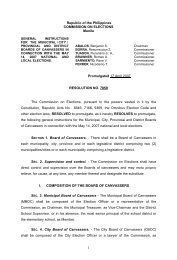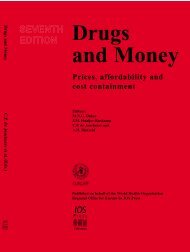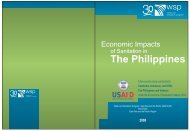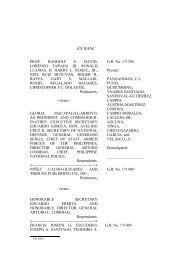Human Rights Committee - Philippine Center for Investigative ...
Human Rights Committee - Philippine Center for Investigative ...
Human Rights Committee - Philippine Center for Investigative ...
Create successful ePaper yourself
Turn your PDF publications into a flip-book with our unique Google optimized e-Paper software.
considered to be hard core. The Department of Social Welfare and Development also<br />
warns that the street children population increases by more than 6,000 every year.<br />
This is alarming considering that the ranks of street children serve as the<br />
wellspring of children accused of violating the law. They suffer from arrest without<br />
judicial warrants <strong>for</strong> allegedly committing robbery snatching, theft, substance abuse,<br />
vagrancy, and concealing a deadly weapon.<br />
Child prisoners belong to the poorest of the poor. They come from families<br />
whose earning falls way below the P6,817 (US$122) monthly income needed to live<br />
decently in 2000, according to NEDA. Poverty threshold indicators show that to live<br />
decently, a family has to earn P3,043 (US$54.5) in 1991, P3,702 (US$66.3) in 1994, and<br />
P4,101 (US$73.5) in 1997.<br />
A number of child prisoners come from families with incomes not exceeding<br />
P2,000 (US$35.8) and P4,000 (US$71.6) per month. This is based on the 1990-2002<br />
statistics of the Social Services Development Department that runs the Molave Youth<br />
Home in Quezon City, that accounts <strong>for</strong> one of the cities with the highest number of child<br />
prisoners in the country.<br />
An analysis of Molave statistics shows that most child prisoners belong to<br />
families living below the poverty threshold, pegged at 39.90 percent in 1991 and at 28.40<br />
percent in 2000 by NEDA.<br />
In 2001, <strong>for</strong> instance, 178 out of 538 Molave detainees (33 percent) came from<br />
families earning below P3,000 (US$53.7). This was followed by 142 children (26<br />
percent) whose family income falls below P4,000. During the same period, only 63<br />
children (12 percent) belonged to families earning less than P6,000 (US$107.5).<br />
A similar pattern could be gleaned during the 11-year period covering 1990 to<br />
2000. Categorized into several income groups, the highest number of Molave prisoners<br />
mostly comes from families earning less than P3,000 (US$53.7). Their number and<br />
percentage vis-à-vis the total number of Molave prisoners are as follows: 121 in 2000<br />
(29 percent); 103 in 1999 (27 percent); 123 in 1996 (47 percent); 102 in 1995 (39<br />
percent); 118 in 1994 (47 percent); 94 in 1993 (48 percent); 91 in 1992 (50 percent); 150<br />
in 1991 (63 percent); and 141 in 1990 (62 percent).<br />
In 1998, the 127 highest number of prisoners in the Molave income grouping<br />
(equivalent to 30 percent) belonged to families with income not exceeding P4,000, while<br />
a total of 101 children (31 percent) accounted <strong>for</strong> the P2,000 income category in 1997.<br />
The state practice of jailing them with adult crime suspects under sub-human<br />
conditions smacks of unlawful discrimination committed by government functionaries,<br />
along with law en<strong>for</strong>cers, on account of the children’s bleak economic status. This<br />
violates the peremptory principle of international law that prohibits discrimination on the<br />
ground of status.<br />
On account of their status of extreme poverty and political powerlessness, sex,<br />
and their young age, the President, together with her top police and Cabinet officials, fail<br />
and refuse to prioritize and take action to spare the children from the inhumanity to<br />
50



